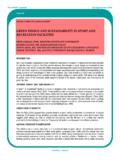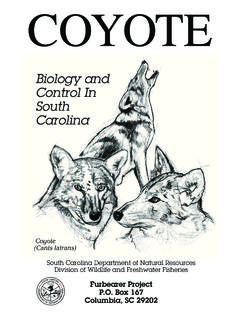Transcription of Measurement of Multidimensional Sport …
1 479 Smith, Smoll, and Grossbard are with the department of Psychology, University of Washington, Seattle, Washington 98195-1525, and Cumming is now with the School for Health, University of Bath, Bath, England, BA2 of Sport & Exercise Psychology, 2006, 28, 479-501 2006 Human Kinetics, of Multidimensional Sport Performance Anxiety in Children and Adults: The Sport Anxiety Scale-2 Ronald E. Smith, Frank L. Smoll, Sean P. Cumming,and Joel R. GrossbardUniversity of WashingtonThis article describes the development and validation of the Sport Anxiety Scale-2 (SAS-2), a Multidimensional measure of cognitive and somatic trait anxiety in Sport performance settings. Scale development was stimulated by fi ndings that the 3-factor structure of the original Sport Anxiety Scale (SAS; Smith, Smoll, & Schutz, 1990) could not be reproduced in child samples and that several items on the scale produced confl icting factor loadings in adult samples. Alternative items having readability levels of grade 4 or below were therefore written to create a new version suitable for both children and adults.
2 Exploratory and confi rmatory factor analyses replicated the original SAS factor structure at all age levels, yielding separate 5-item subscales for Somatic Anxiety, Worry, and Concentration Disrup-tion in samples as young as 9 to 10 years of age. The SAS-2 has stronger factorial validity than the original scale did, and construct validity research indicates that scores relate to other psychological measures as expected. The scale reliably pre-dicts precompetition state anxiety scores and proved sensitive to anxiety-reduction interventions directed at youth Sport coaches and Words: Sport anxiety Measurement , reliability, factorial and construct validityThe study of anxiety, its antecedents, its relations with other psychological variables, and its consequences has a long history of theoretical and empirical attention within Sport psychology. Cognition and arousal are widely considered to be different components of the anxiety response, and a distinction has long been made between cognitive and somatic anxiety (Burton, 1998; Davidson & Schwartz, 1976; Deffenbacher, 1977; Smith, Smoll, & Wiechman, 1998).
3 Moreover, although they interact with one another, cognitive and somatic anxiety can at times be elicited by different antecedents (Burton, 1998; Morris & Engle, 1981; Morris & Liebert, 1973), and they can be differentially related to performance, depending 480 Smith, Smoll, Cumming, and Grossbardon the nature of the task ( , Deffenbacher, 1980; Gould, Petlichkoff, Simons, & Vevera, 1987; Smith, Smoll, & Schutz, 1990). Recent research indicates that different brain regions are involved in different aspects of anxiety, specifi cally, anticipatory anxiety (worrying) and anxious arousal during a task, supporting still further the cognitive-somatic distinction (Heller, Schmidtke, Nitschke, Koven, & Miller, 2002; Hoffman et al., 2005).Theoretical advances stimulated the development of new measuring instru-ments to assess the construct of trait anxiety. During the 1980s and thereafter, Sport -specifi c trait anxiety has frequently been assessed using the Sport Competi-tion Anxiety Test (SCAT; Martens, 1977), a unidimensional measure that does not distinguish between or measure differences in somatic and cognitive anxiety.
4 Although the SCAT has proven to be a valuable research instrument, it measures primarily somatic anxiety (Smith et al., 1990). It is therefore limited in its useful-ness for investigating cognitive aspects of trait anxiety. In 1990, cognitive-affective models of anxiety and empirical fi ndings concerning differential antecedents and consequences of cognitive and somatic anxiety prompted the development of a new Sport -specifi c Multidimensional trait anxiety measure, the Sport Anxiety Scale (SAS; Smith et al., 1990). Developed and cross-validated using both exploratory and confi rmatory factor analysis, the 21-item SAS measures individual differences in somatic anxiety and in two aspects of cognitive anxiety, namely, worry and con-centration disruption (Dunn, Causgrove Dunn, Wilson, & Syrotuik, 2000; Smith et al., 1990). Differential relations of the scales with performance measures have also been reported. For example, Smith et al.
5 (1990) found that concentration disruption was the strongest negative predictor of performance in college football players. Since its development, the SAS has proven useful to researchers in a variety of Sport contexts and appears to be a reliable and valid measure of cognitive and somatic Sport performance anxiety (Giacobbi & Weinberg, 2000; Johnson, Ekengren, & Andersen, 2005; Smith, Ptacek, & Patterson, 2000).Researchers have also been interested in studying performance anxiety in children. To extend Measurement of competitive trait anxiety downward on the age continuum, Martens (1977) developed a children s form of the Sport Competition Anxiety Test (the SCAT-C). Like the adult version of the SCAT, this unidimensional measure proved to be a reliable and valid instrument, and it has been used in many studies to assess the antecedents and consequences of anxiety in children (see Mar-tens, Vealey, & Burton, 1990). Though useful as a global measure of anxiety, the SCAT-C, like its adult counterpart, does not allow for the assessment of separate cognitive and somatic components of that the SAS may not be appropriate for younger age groups appeared when Smith, Smoll, and Barnett (1995) used the SAS as an outcome measure (together with the SCAT-C) in a study involving a coach-training interven-tion designed to reduce situational sources of stress and thereby lower performance trait anxiety.
6 The children in the study ranged in age from 9 to 12 years. Following data collection, a factor analysis of the SAS was carried out to ensure that it was appropriate to use its three subscales as dependent variable measures. The analysis yielded an uninterpretable 5-factor solution with numerous cross-loadings, indi-cating a failure to replicate the 3-factor structure so consistently found in older samples. It was therefore necessary to use the total score as the outcome measure. Although the intervention resulted in highly signifi cant reductions in trait anxiety Sport Anxiety Scale-2 481on both the SAS total score and the SCAT-C (which were highly correlated), it was not possible to assess effects of the intervention on the somatic anxiety, worry, and concentration-disruption components of Sport performance anxiety. In unpublished data derived from 10- to 12-year-old children from a youth basketball program, the SAS s factor structure broke down again in similar fashion, this time with 6 uninterpretable factors (Everett & Barnett, 1995).
7 Failure to replicate the 3-factor SAS model in younger samples suggested two major possibilities, one methodological, the other developmental. At a method-ological level, it seemed possible that the items, originally developed using high school and college athlete samples, were too diffi cult for some younger respondents to understand, and that poor comprehension of item content was responsible for the breakdown of the SAS factor structure. In a previous study using the SAS in a younger sample, Weiss, Ebbeck, and Horn (1997), anticipating this potential problem, deleted 3 of the 21 SAS items and rewrote 6 others to enhance their comprehension for children (p. 56). Unfortunately, Weiss et al. did not factor-analyze their adapted scale to determine whether their modifi cations resulted in the assumed 3-factor structure, so it is not clear whether they were successful in remedying the problem encountered by Smith et al.
8 (1995). To assess potential readability problems in younger samples, we therefore subjected each SAS item to a Flesch-Kincaid readability assessment (Harrison, 1980) and found that many of the items had reading levels above the 9th grade. We therefore concluded that the high reading level of the SAS items renders the scale inappropriate for younger to reproduce the original factor structure in younger children may also refl ect developmental aspects of emotional self-perception. A well-defi ned factor structure derived from a self-report measure indicates that respondents are perceiving distinctions among items and responding differentially to them in ways that produce clusters of items that share common variance and therefore are assumed to have common psychological meaning (Nunnally & Bernstein, 1994). Therefore, another potential reason for the breakdown of the 3-factor SAS structure is that children s emotional self-perception capabilities do not allow them to dif-ferentiate between the three aspects of subjectively experienced anxiety indexed by its are few studies in the literature that address this question of cognitive-affective discrimination.
9 Most developmental research has focused on the ability of children to draw distinctions between discrete emotions, rather than on their ability to make cognitive-affective distinctions. For example, in a cross-sectional study of children in the 3rd, 5th, and 7th grades, Turner and Barrett (2003) performed confi r-matory factor analyses of scores on the Revised Children s Manifest Anxiety Scale (Reynolds & Richmond, 1985) and the Children s Depression Inventory (Kovacs, 1980/1981). At all grade levels, a 2-factor anxiety/depression model exhibited a strong fi t, indicating that children as young as age 7 differentiated between the sub-jective experiences of anxiety and depression. However, Clark and Watson s (1991) tripartite model, which postulates separate factors of physiological hyperarousal, negative affectivity, and low positive affect, also fi t the data well at all three age levels. Because the negative affectivity factor has a signifi cant number of worry items (but also noncognitive arousal items), this fi nding suggests a possible per-ceptual distinction between physiological and cognitive aspects of these emotions 482 Smith, Smoll, Cumming, and Grossbardat even the 3rd-grade level.
10 A study of age-related worry by Muris, Merckelbach, Meesters, and van den Brand (2002) also showed that worry emerged as a cognitive response to stress as early as age 3 and became more elaborated with increasing chronological age, but this study did not relate worry to somatic studies have explored the cognitive-affective components of anxiety from a developmental perspective. In one instance, however, White and Farrell (2001) administered the Revised Children s Manifest Anxiety Scale to children between the ages of 10 and 14 and used confi rmatory factor analysis (CFA) to test several models, all of which posited separate arousal and worry factors. Their analyses provided evidence of cognitive-somatic differentiation. However, the average participant in this study was nearly 12 years old and no analyses were done by age group, so that we cannot be certain of cognitive-somatic differentiation in the younger age groups.





